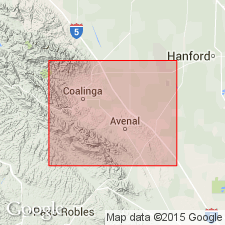
- Usage in publication:
-
- San Joaquin clays
- Modifications:
-
- Named
- Dominant lithology:
-
- Clay
- AAPG geologic province:
-
- San Joaquin basin
Summary:
Pg. 178-192. San Joaquin clays applied to upper third of Etchegoin beds (new), from Coalinga northward in San Joaquin Valley, California. Clays have banded appearance from zones of color 200 or 300 feet thick. Total thickness is about 1,500 feet. Overlies Etchegoin sands of Etchegoin beds. Conformably underlies Tulare formation (new). North of Tar Springs, Kings County, specimens of SCUTELLA GIBBS [echinoderm] and teeth of sharks have been found. Age is Pliocene.
Source: US geologic names lexicon (USGS Bull. 896, p. 703, 1912); GNU records (USGS DDS-6; Menlo GNULEX).
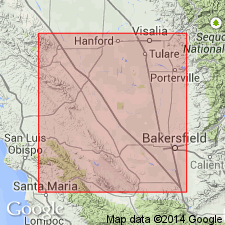
- Usage in publication:
-
- San Joaquin clay
- Modifications:
-
- Principal reference
- AAPG geologic province:
-
- San Joaquin basin
Summary:
Pg. 476-499. San Joaquin clay described at type section herein designated. Thickness 1,860 feet. Unconformably underlies Tulare formation; overlies with apparent conformity Etchegoin sand. Described in subsurface of southern San Joaquin Valley from well logs. Age is late Pliocene and early Pleistocene.
Type section: lower east side of North Dome, Kettleman Hills, in sec. 23, T. 22 S., R. 18 E., Fresno and Kings Cos., San Joaquin Valley, southern CA.
Type locality: North Dome, Kettleman Hills, Fresno and Kings Cos., CA.
Source: US geologic names lexicon (USGS Bull. 1200, p. 3446); GNU records (USGS DDS-6; Menlo GNULEX).

- Usage in publication:
-
- San Joaquin formation*
- Modifications:
-
- Revised
- AAPG geologic province:
-
- San Joaquin basin
Summary:
Restricted Etchegoin to lower two-thirds of Etchegoin formation as originally defined [Anderson, 1905] and used in previous publications, and applied San Joaquin formation to upper part (previously called San Joaquin clays [Anderson, 1905]). Age is Pliocene.
Source: US geologic names lexicon (USGS Bull. 896, p. 703, 1912)
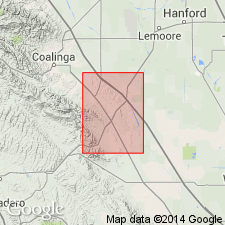
- Usage in publication:
-
- San Joaquin formation*
- Modifications:
-
- Adopted
- Revised
- Redescribed
- Biostratigraphic dating
- Dominant lithology:
-
- Sandstone
- Silt
- Clay
- AAPG geologic province:
-
- San Joaquin basin
Summary:
Pg. 27-53, pl. 3. San Joaquin clay of Goudkoff (1934) is adopted as San Joaquin formation for greater part of apparently nonmarine and marine strata underlying nonmarine Tulare formation; overlies Etchegoin formation. This usage restricts name Etchegoin as by by Arnold and Anderson (1910, USGS Bull. 398). Predominantly fine-grained silty sandstone, silt, clay, and beds of gravel or conglomerate interbedded with fine-grained sandstone. Thickness about 1,200 to 1,800 [1,700?] feet. Includes Cascajo conglomerate member (new) at base. Faunal zone mapped; fossil lists and measured sections included for upper Mya, Acila, Pecten, and Neverita zones, and descriptions of strata between zones. Shown on geologic map of Kettleman Hills. Age is late Pliocene.
[Discrepancy: GNC records (US geologic names lexicon, USGS Bull. 1200, p. 3446) indicates maximum total thickness is 1,800 feet; GNU records (USGS DDS-6; Menlo GNULEX) indicate maximum total thickness is 1,700 feet. --unresolved.]
Source: US geologic names lexicon (USGS Bull. 1200, p. 3446); GNU records (USGS DDS-6; Menlo GNULEX).
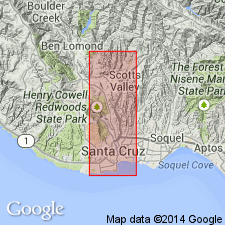
- Usage in publication:
-
- San Joaquin Formation*
- Modifications:
-
- Age modified
- Biostratigraphic dating
- AAPG geologic province:
-
- San Joaquin basin
Summary:
San Joaquin Formation includes early Pliocene vertebrates in its lower part in Kettleman Hills, its type locality. [Thus overall age is early and late Pliocene].
Source: GNU records (USGS DDS-6; Menlo GNULEX).
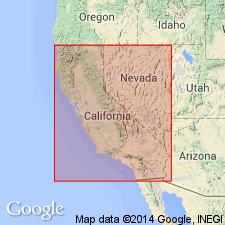
- Usage in publication:
-
- San Joaquin Formation*
- Modifications:
-
- Geochronologic dating
- AAPG geologic province:
-
- San Joaquin basin
Summary:
Fission-track age on zircon yielded 4.6 +/-0.5 Ma and K-Ar age on plagioclase yielded 4.5 +/-0.8 Ma from San Joaquin Formation in Kettleman Hills.
Source: GNU records (USGS DDS-6; Menlo GNULEX).
For more information, please contact Nancy Stamm, Geologic Names Committee Secretary.
Asterisk (*) indicates published by U.S. Geological Survey authors.
"No current usage" (†) implies that a name has been abandoned or has fallen into disuse. Former usage and, if known, replacement name given in parentheses ( ).
Slash (/) indicates name conflicts with nomenclatural guidelines (CSN, 1933; ACSN, 1961, 1970; NACSN, 1983, 2005, 2021). May be explained within brackets ([ ]).

